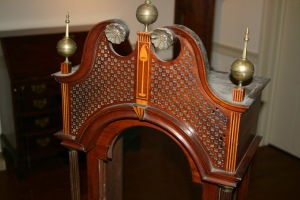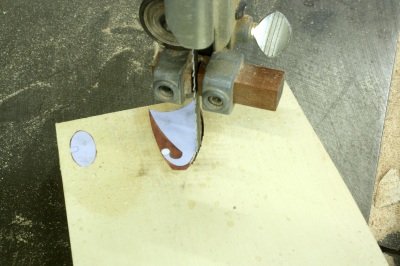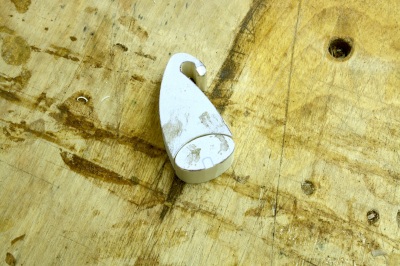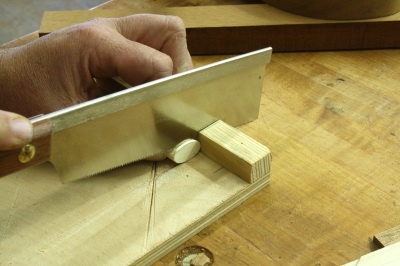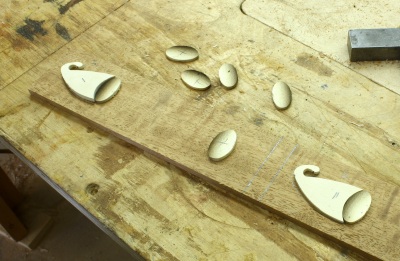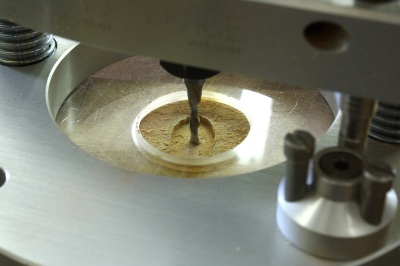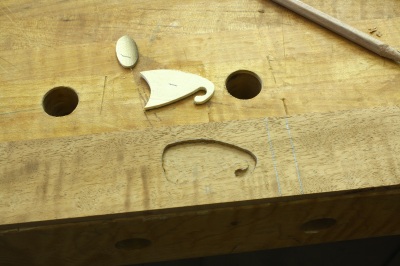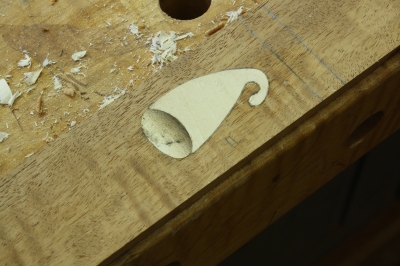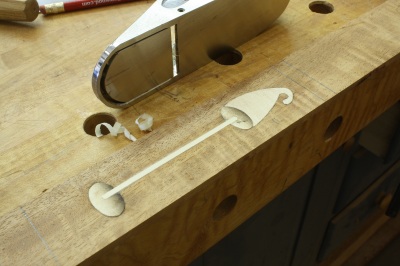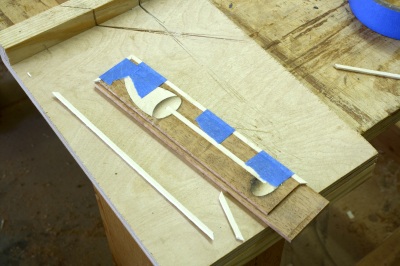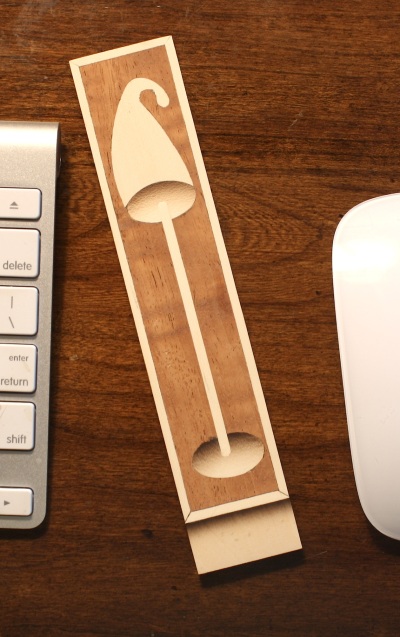 Yesterday was family day, so if I was going to get anything done this weekend, it would have to be in the shop today. I had a few things to catch up on, and I planned to inlay the box I’m working on. After I fixed a drop finial that was broken off my highboy and reshaped a few brass mallet inserts, I installed hinges on the clock waist doors then got to the box.
Yesterday was family day, so if I was going to get anything done this weekend, it would have to be in the shop today. I had a few things to catch up on, and I planned to inlay the box I’m working on. After I fixed a drop finial that was broken off my highboy and reshaped a few brass mallet inserts, I installed hinges on the clock waist doors then got to the box.
 The first order of business was to make the fans. I decided to make and use fans with three sections instead of the four sections in my original drawings – four sections were too wide for the box front. I sand shaded the fans a little just to provide a hint of visual depth. I then laid the fans onto the box front to arrange a pleasing layout.
The first order of business was to make the fans. I decided to make and use fans with three sections instead of the four sections in my original drawings – four sections were too wide for the box front. I sand shaded the fans a little just to provide a hint of visual depth. I then laid the fans onto the box front to arrange a pleasing layout.
 Once I had the layout set, I traced around the outside of the fans. One thing to remember is to flip the fans as you transfer the layout. Otherwise you could find yourself positioning a fan with its less-desirable face up because sometimes (most times) the fans are not perfectly symmetrical as to allow it.
Once I had the layout set, I traced around the outside of the fans. One thing to remember is to flip the fans as you transfer the layout. Otherwise you could find yourself positioning a fan with its less-desirable face up because sometimes (most times) the fans are not perfectly symmetrical as to allow it.
 The next step was to waste out the area where the fans fit. I worked the first fan recess by routing out the waste then setting the lines using my chisels and a #3 carving gouge. On the second recess, I struck the lines then routed away the waste. (I did the third fan recess this way as well, but as far as I can tell, there is little difference. Both methods work equally good. Cut as close to the line as you can without nicking it, then clean away the balance using the chisel.
The next step was to waste out the area where the fans fit. I worked the first fan recess by routing out the waste then setting the lines using my chisels and a #3 carving gouge. On the second recess, I struck the lines then routed away the waste. (I did the third fan recess this way as well, but as far as I can tell, there is little difference. Both methods work equally good. Cut as close to the line as you can without nicking it, then clean away the balance using the chisel.
 The fans were glued in place using regular yellow glue just before I left for lunch. When I returned about an hour later, I first sanded the top, ends and back of the box to #180 grit. I then peeled the blue tape from each fan. As I looked at the box, I thought it looked a bit plain. Because I have no set box to create (I’m free-wheeling it), I decided to add another spot of inlay.
The fans were glued in place using regular yellow glue just before I left for lunch. When I returned about an hour later, I first sanded the top, ends and back of the box to #180 grit. I then peeled the blue tape from each fan. As I looked at the box, I thought it looked a bit plain. Because I have no set box to create (I’m free-wheeling it), I decided to add another spot of inlay.
 I settled on a small blackwood dot above each fan. To make the dots, I used a 3/8″ plug cutter then sliced the discs off using a handsaw – that way I could control the thickness of each disc. The recesses for the dots was nothing more than a shallow hole from a Forstner drill bit. Once the holes was cut, I dropped a bit of glue into the hole and set the disc in place. After the glue had enough time to dry and after I had cut, shaped and installed a simple handle in the lid portion of the box, I leveled the front of the box as shown in the opening photo.
I settled on a small blackwood dot above each fan. To make the dots, I used a 3/8″ plug cutter then sliced the discs off using a handsaw – that way I could control the thickness of each disc. The recesses for the dots was nothing more than a shallow hole from a Forstner drill bit. Once the holes was cut, I dropped a bit of glue into the hole and set the disc in place. After the glue had enough time to dry and after I had cut, shaped and installed a simple handle in the lid portion of the box, I leveled the front of the box as shown in the opening photo.
I add a couple hinges during the week, and I hope to use rare-earth magnets to keep the box closed. After that, I’ll apply a few coats of my oil/varnish mixture and that should do it. If I missed anything that you’d like to know, please drop your question in the comment section below. I’ll get you a reply in short order.
Build Something Great!
Glen








 If you’re using 3/4″-thick material, after the 1/8″ groove you have 5/8″ of thickness remaining. For me this is a bit of work completed at the router table. Set the height of the bit then adjust the fence so its aligned with the router bit exactly at the table’s top edge. This takes advantage of the entire thickness of your blade – if you’re slightly thinner after your cut, that’s OK, but do not leave a flat on the edge of the dovetail. (Notice the solid push block used to guide the tall drawer divider through the cut.) After you have the dovetail ends created, cut away the back edge leaving a 1″-wide dovetail – trim the dovetail away flush with the square shoulder on your blade.
If you’re using 3/4″-thick material, after the 1/8″ groove you have 5/8″ of thickness remaining. For me this is a bit of work completed at the router table. Set the height of the bit then adjust the fence so its aligned with the router bit exactly at the table’s top edge. This takes advantage of the entire thickness of your blade – if you’re slightly thinner after your cut, that’s OK, but do not leave a flat on the edge of the dovetail. (Notice the solid push block used to guide the tall drawer divider through the cut.) After you have the dovetail ends created, cut away the back edge leaving a 1″-wide dovetail – trim the dovetail away flush with the square shoulder on your blade.
 It’s time to define the socket. This is where your ability to saw comes into play. Cut the two sides of your layout down to the inch mark. Follow both lines as you saw. After you’ve established the socket’s outer edges, make a few additional saw cuts between the lines – the more kerfs you have, the easier the next couple steps become and the cleaner your socket will be to work.
It’s time to define the socket. This is where your ability to saw comes into play. Cut the two sides of your layout down to the inch mark. Follow both lines as you saw. After you’ve established the socket’s outer edges, make a few additional saw cuts between the lines – the more kerfs you have, the easier the next couple steps become and the cleaner your socket will be to work. You can jam a chisel into the slots, or if they’re thin enough, you can break the pieces out with your fingers. The neat things is that when they break – due to the grain orientation – the slivers break flush with the bottom edge of the socket. (Sometimes they do break slightly above the line.) With the pieces out of the way, pare the socket bottom so it’s smooth and level. Make sure the socket is level from outside to inside. And it wouldn’t hurt to slope a bit toward the inside – that guarantees you’ll have a tight fit on the exterior of your case.
You can jam a chisel into the slots, or if they’re thin enough, you can break the pieces out with your fingers. The neat things is that when they break – due to the grain orientation – the slivers break flush with the bottom edge of the socket. (Sometimes they do break slightly above the line.) With the pieces out of the way, pare the socket bottom so it’s smooth and level. Make sure the socket is level from outside to inside. And it wouldn’t hurt to slope a bit toward the inside – that guarantees you’ll have a tight fit on the exterior of your case. If you’ve sawn to the layout lines and trimmed the socket even at the bottom, your blades should fit easily. Brush glue onto the dovetail and into the socket (the best glue surface is the flat-grain to flat-grain connection at the bottom of the socket), then drive the workpiece home. By the way, don’t forget to repeat these steps twice for each drawer blade or divider. Test-fits are terrible with only one socket cut.
If you’ve sawn to the layout lines and trimmed the socket even at the bottom, your blades should fit easily. Brush glue onto the dovetail and into the socket (the best glue surface is the flat-grain to flat-grain connection at the bottom of the socket), then drive the workpiece home. By the way, don’t forget to repeat these steps twice for each drawer blade or divider. Test-fits are terrible with only one socket cut.


























